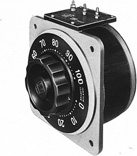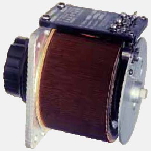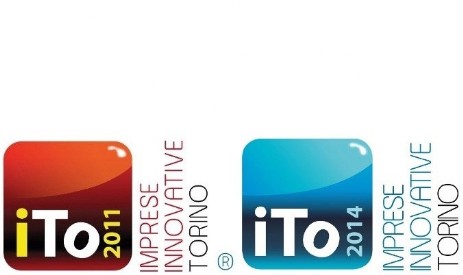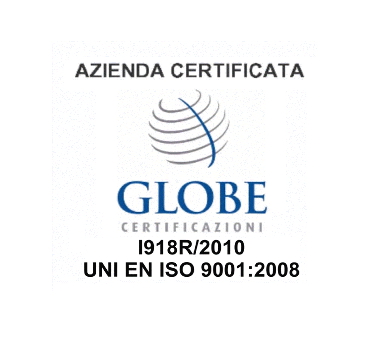VARIAC MONOFASE SERIE V - ALIMENTATORI ELETTRONICI-VARIAC-TRASFORMATORI
Menu principale:
VARIAC MONOFASE SERIE V
Regolatori di tensione
Voltage Regulators
The autotransformer is an efficient, trouble-free device for controlling A.C. voltage. Unlike most transformers, our voltage regulator has a transformation ratio that can be smoothly and continuosly changed so the output of the unit can be controlled from zero to line voltage or even higher.
Features:
EFFICIENT -transforms power more efficiently than rheostats
DURABLE -because it runs cool (40/50° C max)
OVERLOAD-ABLE withstands 1000% overloads short term
-Independent of load size or power factor - voltage to the load changes little from full load to none.
- Produce an adjustable output voltage that is a sine wave. Only the voltage magnitude is changed; the shape of the voltage is not distorted.
-Handle all load power factors.
-Can be used to adjust banks of capacitors and/or inductors.
Applications:
-Regulate voltage (over and under-voltage testing of electrical and electronic equipments).
- Speed control
-Lighting control in theatres, hotels, photographic studios
-Motor test stands
-Power supplies
-Industrial process heating control
-Source voltage & load banks for electrical testing:
• circuit breaker
• uninterruptible power supplies
• generators
-Control of D.C. voltage and current through rectifiers
-Control of rectifiers in electroplating etc.
-Supply voltage adjustment (automatic voltage stabilisers)
Construction:
Manufacturing standards
Designed and tested according to VDE-0552 and
IEC 61558-2-14; designed as toroidal autotransformer.
Core
All regulators use grain-oriented strip wound silicon steel cores ensuring low losses and reduce magnetizing current.
Windings
The winding, wich is insulated from the core by precision moulded winding formers, comprises a single layer (class H wire) carefully wound to provide a flat surface for the brushgear.
Brushgear
Easily replaceable carbon brush units are used, the resistance of the brush being carefully calculated to limit the current circulating in the bridged turns.
It is therefore most important that only the correct replacement brush is used in any particular original's. Brushes are mounted in robust brush carriers insulated from the shaft, and designed so that metal parts cannot come into contact with the winding in the event of brush fracture.
Frames
The wound core and brushgear are mounted on a rugged cast aluminium frame providing strenght combined with minimum weight. The bases incorporated mounting holes providing interchangeable fixing centres with many other variable autotransformers.
General specifications and terminology
The data given in the table on pag. 6-7 should be read in conjunction with the following general specifications.
Input Voltage:
the supply voltage to which the variable transformer is connected.
Output Voltage:
the range of voltage available at the output terminals.
Frequency:
all units in this catalog operate in the range of 50 to 400 Hz.
Rated Current:
output current that can be drawn at any brush setting for a continous duty.
Intermittent Operation:
the current rating may be multiplied by the square root of the Duty Cycle Ratio, this being defined as the off-plus-on-time divided by on-time. The resulting up-rated current must be compared with the short-time overload current (see Fig. 3), the lower of the two figures being the maximum permissible current.
Ambient Temperature:
current ratings apply up to 45°C ambient. Fig. 4, must be applied for more elevated temperatures.
KVA Rating:
the maximum output current at maximum output line voltage multiplied by that max voltage and divided by 1000 for single-phase. Divide by 577 for three-phase (1000/V3).
Line-Voltage and over-Voltage connection:
with line-voltage connections, the supply is connected across the whole winding, and the maximum output equals the applied voltage. In over-voltage connection, the supply is applied to a tapping provided instead of to the whole winding, giving e.g.: 0-280 Volt from a 220 Volt supply.
Insulation:
all variable transformers are flash-tested at 2,5 KV. rms 50 Hz.
Types Available: Terminology
Frame Sizes
The variable autotransformers are made in seven basic series or frame size V1 - V3 - V5 - V10 -V20 - V40 - V70. Electrical specifications are given in the detailed tabulations for the various models on pag. 6-7 following.
Optional features can be provided.
Single and three phase
Single phase - Suffix V / Three phase - Suffix T
Uncovered models
All basic variable transformers are available in uncovered form. These units are designed with the suffix: NA (ex V5 NA Single phase uncovered, T5 NA Three phase uncovered).
Covered models
All single units and ganged assemblies are available in acratively styled enclosure Suffix: NC (ex V 5 NC single phase covered).
Portable models
V1 - V3 - V5 - V10 - V20 series can be supplied in portable cases with carrying handles, input lead, switch, output fuse. A digital voltmeter LED (suffix PV) can be provided. The portable models are also available with voltmeter and ammeter (suffix PVA)
Output receptacles
In the models covered and portable the output can
be taken through:
a) socket type “schuko” (up to 10 A) suffix SCH
b) CEE socket 16-32-64 A suffix CES16, CES32, CES64
c) insulated terminals suffix ILT
Motor Drive
All open and covered voltage regulators are available with reversing motor drive for remote control and automatic applications. Suffix: M
Ganged assemblies
All voltage regulators are available assemblies of two, three, four, five, six units operating on one common shaft for parallel or series. The number following the suffix NA or NC indicated the number of ganged regulators (add SR for series connection)
Exemple: V 70 NA/6-M is a single phase uncovered motor-drive regulator with six units in parallel. V 70 NA/2SR-M two units series connection.
Optional features
Non standard voltage or non standard current, limit switches, special shaft and special motors can be supplied to customer’s special requirements.
Se volete chiederci informazioni sugli articoli presenti in questa pagina, o per qualsiasi altra comunicazione, potete inviarci una mail dal form qui a lato 






